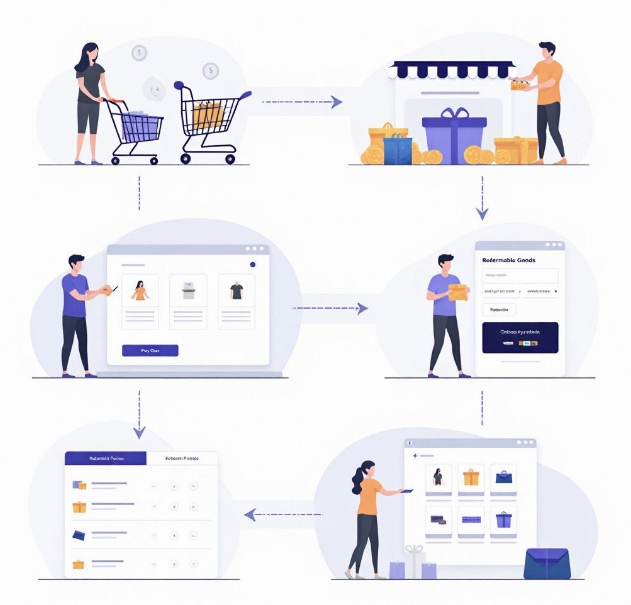Integral Mall and E-commerce Integration: How to Build a High Conversion Rate System?
- latest articles
- 1.DApp Development & Customization: Merging Diverse Market Needs with User Experience 2.Analysis of the Core Technical System in DApp Project Development 3.How to achieve cross-chain interoperability in Web3 projects? 4.How does the tokenization of points reconstruct the e-commerce ecosystem? 5.How to Set and Track Data Metrics for a Points Mall? 6.What is DApp Development? Core Concepts and Technical Analysis 7.Inventory of commonly used Web3 development tools and usage tips 8.Development of a Distribution System Integrated with Social E-commerce 9.Six Key Steps for Businesses to Build a Points Mall System 10.What is DApp Development? A Comprehensive Guide from Concept to Implementation
- Popular Articles
- 1.Future Trends and Technology Predictions for APP Development in 2025 2.Analysis of the DeFi Ecosystem: How Developers Can Participate in Decentralized Finance Innovation 3.From Zero to One: How PI Mall Revolutionizes the Traditional E-commerce Model 4.DAPP Development | Best Practices for Professional Customization and Rapid Launch 5.Recommended by the Web3 developer community: the most noteworthy forums and resources 6.From Cloud Computing to Computing Power Leasing: Building a Flexible and Scalable Computing Resource Platform 7.How to Develop a Successful Douyin Mini Program: Technical Architecture and Best Practices 8.Shared Bike System APP: The Convenient Choice in the Era of Smart Travel 9.How to Create a Successful Dating App: From Needs Analysis to User Experience Design 10.From Design to Development: The Complete Process of Bringing an APP Idea to Life
With the rapid development of the internet, competition in the e-commerce industry is becoming increasingly fierce. How merchants can stand out among numerous platforms and enhance user stickiness and conversion rates has become an urgent problem to solve. In this process, points malls, as an innovative marketing tool, are being widely adopted by e-commerce platforms. How can the integration of points malls with e-commerce create a high-conversion system? This article will delve into this topic from multiple perspectives, analyze the role of points malls, and provide specific strategies and recommendations.
I. The Concept and Role of Points Malls
A points mall, as the name suggests, is a marketing tool where e-commerce platforms use a points system to reward users, allowing them to accumulate points and redeem them for products or coupons. It is not only an effective tool for e-commerce platforms to enhance user activity and loyalty but also a way for merchants to interact with users through points and products.
1. Enhancing User Stickiness
Points malls are an effective way for e-commerce platforms to attract users and increase user activity. Through the points system, users accumulate points when shopping or participating in activities on the platform. This reward mechanism can stimulate users' interest in participation, thereby continuously increasing their activity on the platform. In the long run, points malls can transform simple transactional behavior into long-term customer loyalty, reducing customer churn.
2. Encouraging Repeat Purchases and Referrals
Points not only motivate consumers to make purchases but also incentivize repeat purchases through well-designed point rules. For example, e-commerce platforms can assign points for orders of a certain value. After redeeming products or coupons, users feel satisfied with the rewards, increasing the likelihood of repeat purchases. At the same time, points malls can encourage users to earn points by sharing and referring, further expanding the platform's user base.
3. Promoting Product Circulation
The product redemption mechanism in points malls not only stimulates consumers' purchasing desire but also helps e-commerce platforms promote slow-moving products and clear inventory. For example, setting a certain number of points to exchange for low-priced products or offering point-based discount activities can accelerate product circulation. This approach not only increases product sales but also improves the platform's inventory turnover rate.
II. How to Integrate with E-commerce Systems
Integrating points malls with e-commerce platforms is not simply about embedding them into the system. It also requires developing appropriate operational models and strategies based on different business needs to ensure that points malls can deliver maximum benefits.
1. Deep Integration of Points with Consumer Behavior
The core of integrating points malls with e-commerce lies in deeply linking points with consumers' purchasing behavior. Points can be accumulated based on factors such as purchase amount, product category, and purchase frequency to enhance users' desire to buy. For example, different point tiers can be set, where purchasing more products earns more points, or double-point events can be launched during specific holidays to stimulate users' consumption enthusiasm.
Additionally, to further strengthen the bond between points and consumption, e-commerce platforms can leverage big data analytics to create precise user profiles and develop personalized point schemes for more effective user incentives.
2. Diverse Choices for Redeeming Products and Coupons
The variety of products and coupons in points malls should be diverse to meet the needs of different consumers. On one hand, the mall can offer redemption for the platform's own products. On the other hand, collaborations with other brands can introduce cross-brand and cross-category redemption products to enhance the platform's appeal and user engagement.
At the same time, to improve conversion rates, e-commerce platforms can increase users' willingness to redeem by offering coupons. Consumers can accumulate points to obtain shopping vouchers, cash coupons, or free shipping coupons, which not only boosts purchase conversion rates but also helps merchants achieve targeted promotions.
3. Adding Social Features
Socialization is key to enhancing user stickiness and conversion rates. By integrating points malls with social features, e-commerce platforms can encourage users to share and refer, thereby gaining more user data and expanding their influence. For example, platforms can implement point-sharing features, where users earn points by sharing products or mall pages on social media, sparking enthusiasm for spreading platform content.
Additionally, through a socialized points system, users can participate in point redemption activities with friends, creating a collective purchasing atmosphere and further increasing conversion rates.
4. Regular Promotions and Holiday Events
Utilizing holiday promotions is another important way to boost the conversion rate of points malls. E-commerce platforms can launch events such as double points, limited-time product redemptions, or point-based discounts during different holidays to attract users' attention. During these events, users are often willing to increase their purchases because they can use points to get more benefits.
5. Data Analysis and Optimization
Data analysis and optimization are indispensable in the process of integrating points malls with e-commerce systems. E-commerce platforms should regularly analyze data from points malls to understand users' purchasing behavior, point usage, and redemption preferences, thereby providing a basis for optimizing marketing strategies.
For example, data analysis may reveal that certain products have low redemption rates in points malls, possibly due to high pricing or unreasonable redemption conditions. To address these issues, merchants can adjust product prices or optimize redemption rules to increase the popularity of these products in points malls.
III. How to Improve Conversion Rates
Conversion rate is a core metric for e-commerce platform profitability. The design and operation of points malls should always focus on improving conversion rates. Below are some strategies to enhance the conversion rate of points malls:
1. Optimize Point Earning and Usage Rules
Simplify the rules for earning and using points so that users can clearly understand how to accumulate points quickly and how to redeem them. This avoids confusion and resistance due to complex rules, thereby increasing user participation.
2. Accurate User Profiling and Personalized Recommendations
Accurate user profiling helps merchants implement personalized point rewards. For example, by analyzing users' purchase history, merchants can recommend relevant products based on users' interests and needs and offer specific point rewards. Personalized recommendations not only increase users' desire to purchase but also enhance the conversion rate of points malls.
3. Combining Coupons with Points
Combining coupons with points is another important method to improve conversion rates. Merchants can incentivize users to purchase more by setting up "point redemption for coupons" or "discount coupons + points mall redemption." Coupons offer direct discounts, while the process of accumulating points increases user engagement. The combination of both can effectively boost conversion rates.
4. Quick Redemption and Low Thresholds
If the redemption threshold in points malls is too high, users may feel disappointed, which could dampen their participation enthusiasm. Therefore, merchants should appropriately lower the redemption threshold to allow more users to enjoy the benefits of points. For example, offering products or coupons with low point requirements can encourage users to participate multiple times and accumulate more points.
IV. Summary
The integration of points malls with e-commerce not only brings higher user stickiness and repeat purchase rates to e-commerce platforms but also provides merchants with more precise marketing tools. By optimizing point earning and usage rules, designing personalized point rewards, strengthening social features, and conducting data analysis and optimization, merchants can continuously improve the conversion rate of points malls, thereby achieving higher business returns.
However, the success of points malls does not happen overnight. Merchants must flexibly adjust strategies based on actual conditions and continuously monitor market changes and user feedback to build an efficient points mall conversion system.
-

How does the tokenization of points reconstruct the e-commerce ecosystem?
With the continuous advancement of internet technology and the gradual prolifera···
-

How to Set and Track Data Metrics for a Points Mall?
With the rapid development of the e-commerce industry, points malls, as a common···
-

Development of a Distribution System Integrated with Social E-commerce
With the rapid development of internet technology, the e-commerce industry has e···

 Blockchain
Blockchain












